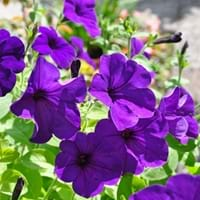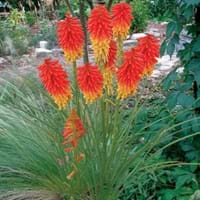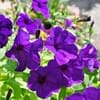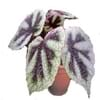Life Span
Annual
Perennial
Type
Flowering Plants, Shrubs
Perennial
Origin
Hybrid origin
Hybrid origin
Number of Varieties
Not Available
Habitat
Terrestrial
Damp Places, Marshy ground
USDA Hardiness Zone
9-10
6-9
Sunset Zone
A1, A2, A3, H1, H2, 1a, 1b, 2a, 2b, 3a, 3b, 4, 5, 6, 7, 8, 9, 10, 11, 12, 13, 14, 15, 16, 17, 18, 19, 20, 21, 22, 23, 24
2a, 2b, 3a, 3b, 4, 5, 6, 7, 8, 9, 14, 15, 16, 17, 18, 19, 20, 21, 22, 23, 24
Habit
Prostrate/Trailing
Clump-Forming
Flower Color
White, Blue, Purple, Pink, Light Pink, Hot Pink, Magenta, Lavender
Yellow, Red, Orange, Pink
Flower Color Modifier
Bicolor
Bicolor
Fruit Color
Not Available
Not Available
Leaf Color in Spring
Green
Green, Blue Green
Leaf Color in Summer
Green
Green, Blue Green
Leaf Color in Fall
Green
Blue Green, Gray Green, Light Yellow
Leaf Color in Winter
Light Green
Light Green
Plant Season
Spring, Summer, Fall
Spring, Summer
Sunlight
Full Sun
Full Sun, Partial Sun
Growth Rate
Very Fast
Medium
Type of Soil
Loam, Sand
Clay, Loam, Sand
The pH of Soil
Acidic, Neutral
Acidic, Neutral
Soil Drainage
Well drained
Well drained
Bloom Time
Indeterminate
Early Summer, Summer
Tolerances
Drought
Drought
Where to Plant?
Container, Ground, Pot
Container, Ground
How to Plant?
Seedlings, Transplanting
Divison, Seedlings
Plant Maintenance
Medium
Medium
Watering Requirements
Keep the ground moist but not water-logged, Requires regular watering, Requires watering in the growing season
Needs more water during establishment, Water Deeply, Water in morning to avoid prompting diseases, Water in the early morning hours
In Summer
Lots of watering
Lots of watering
In Spring
Moderate
Moderate
In Winter
Average Water
Average Water
Soil pH
Neutral
Acidic, Neutral
Soil Type
Loamy, Sandy
Clay, Loam, Sand
Soil Drainage Capacity
Well drained
Well drained
Sun Exposure
Full Sun, Partial shade
Full Sun, Partial Sun
Pruning
Cut or pinch the stems, Do not prune during shooting season, Remove dead or diseased plant parts, Remove deadheads
Cut or pinch the stems, Remove damaged leaves, Remove dead branches, Remove dead leaves
Fertilizers
All-Purpose Liquid Fertilizer
All-Purpose Liquid Fertilizer, Apply N-P-K
Pests and Diseases
Red blotch
Onion thrips, Red blotch, Root rot
Plant Tolerance
Drought
Drought, Moisture
Flower Petal Number
Single
Single
Foliage Texture
Medium
Coarse
Foliage Sheen
Matte
Matte
Attracts
Hummingbirds, Butterflies
Snails
Allergy
Not Available
Not Available
Aesthetic Uses
Beautification, Bouquets, Showy Purposes
Borders, Cottage Garden, Ground Cover
Beauty Benefits
Not Available
Not Available
Environmental Uses
Air purification
Air purification
Medicinal Uses
Not Available
Not Available
Part of Plant Used
Flowers
Not Available
Other Uses
Showy Purposes
Not Available
Used As Indoor Plant
Yes
No
Used As Outdoor Plant
Yes
Yes
Garden Design
Hanging Basket
Container, Cutflower, Mixed Border, Rock Garden, Wall
Botanical Name
PETUNIA 'PAS3187'
KNIPHOFIA 'Border Ballet'
Common Name
Purple Wave Petunia, Spreading Petunia, Wave Purple Petunia
Tritoma, Wisley Blue Spring Starflower, Wisley Blue Springstar
In Hindi
Purple wave petunia
Tritoma
In German
Lila Welle Petunie
Tritoma
In French
Pétunia pourpre Vague
Tritoma
In Spanish
Petunia púrpura Wave
tritoma
In Greek
Purple Wave πετούνια
tritoma
In Portuguese
Onda roxa do petúnia
Tritoma
In Polish
Purpurowy fali petunii
Tritoma
In Latin
Purpura unda Petunia
Trytoma
Phylum
Magnoliophyta
Tracheophyta
Class
Magnoliopsida
Magnoliopsida
Order
Solanales
Asparagales
Family
Solanaceae
Liliaceae
Clade
Angiosperms, Asterids, Eudicots
Angiosperms, Monocots
Tribe
Not Available
Not Available
Subfamily
Petunioideae
Not Available
Season and Care of Purple Wave Petunia and Tritoma
Season and care of Purple Wave Petunia and Tritoma is important to know. While considering everything about Purple Wave Petunia and Tritoma Care, growing season is an essential factor. Purple Wave Petunia season is Spring, Summer and Fall and Tritoma season is Spring, Summer and Fall. The type of soil for Purple Wave Petunia is Loam, Sand and for Tritoma is Clay, Loam, Sand while the PH of soil for Purple Wave Petunia is Acidic, Neutral and for Tritoma is Acidic, Neutral.
Purple Wave Petunia and Tritoma Physical Information
Purple Wave Petunia and Tritoma physical information is very important for comparison. Purple Wave Petunia height is 10.20 cm and width 90.00 cm whereas Tritoma height is 45.70 cm and width 50.80 cm. The color specification of Purple Wave Petunia and Tritoma are as follows:
Purple Wave Petunia flower color: White, Blue, Purple, Pink, Light Pink, Hot Pink, Magenta and Lavender
Purple Wave Petunia leaf color: Green
Tritoma flower color: Yellow, Red, Orange and Pink
- Tritoma leaf color: Green and Blue Green
Care of Purple Wave Petunia and Tritoma
Care of Purple Wave Petunia and Tritoma include pruning, fertilizers, watering etc. Purple Wave Petunia pruning is done Cut or pinch the stems, Do not prune during shooting season, Remove dead or diseased plant parts and Remove deadheads and Tritoma pruning is done Cut or pinch the stems, Remove damaged leaves, Remove dead branches and Remove dead leaves. In summer Purple Wave Petunia needs Lots of watering and in winter, it needs Average Water. Whereas, in summer Tritoma needs Lots of watering and in winter, it needs Average Water.





